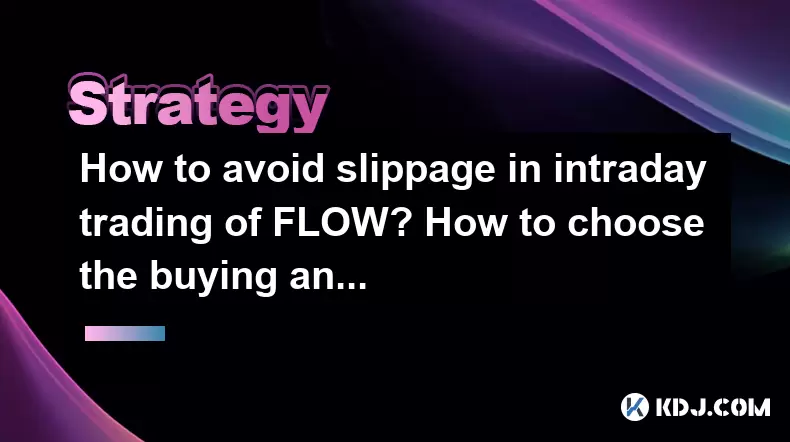-
 bitcoin
bitcoin $110918.433029 USD
-1.69% -
 ethereum
ethereum $3996.872473 USD
-2.43% -
 tether
tether $1.000594 USD
0.00% -
 bnb
bnb $1178.871834 USD
-2.38% -
 xrp
xrp $2.413973 USD
-3.47% -
 solana
solana $194.341461 USD
-4.24% -
 usd-coin
usd-coin $0.999963 USD
-0.03% -
 tron
tron $0.320092 USD
0.92% -
 dogecoin
dogecoin $0.196919 USD
-3.42% -
 cardano
cardano $0.669585 USD
-3.63% -
 hyperliquid
hyperliquid $37.485952 USD
-3.58% -
 ethena-usde
ethena-usde $1.000026 USD
-0.02% -
 chainlink
chainlink $18.018220 USD
-5.13% -
 bitcoin-cash
bitcoin-cash $523.879267 USD
-2.41% -
 stellar
stellar $0.324655 USD
-3.67%
How to avoid slippage in intraday trading of FLOW? How to choose the buying and selling points?
Slippage in FLOW trading can impact profitability; use limit orders, trade during high liquidity, and monitor order book depth to minimize it.
May 07, 2025 at 04:35 pm

Introduction to Slippage in Intraday Trading of FLOW
Slippage is a common phenomenon in intraday trading, particularly with volatile cryptocurrencies like FLOW. It occurs when there is a difference between the expected price of a trade and the price at which the trade is executed. This can significantly impact the profitability of intraday trading. Understanding how to minimize slippage is crucial for traders looking to maximize their returns when trading FLOW.
Understanding the Nature of FLOW and Its Market
FLOW, a blockchain platform designed for building and running decentralized applications, experiences significant price volatility. This volatility can lead to higher instances of slippage, especially during periods of high trading volume or significant news events. Traders need to be aware of the market conditions and liquidity of FLOW to effectively manage slippage.
Strategies to Minimize Slippage in FLOW Trading
To minimize slippage when trading FLOW, traders can employ several strategies. These include:
Using Limit Orders: Instead of using market orders, which are executed at the best available price and can result in slippage, traders can use limit orders. A limit order is set to execute at a specific price or better, thereby reducing the risk of slippage.
Trading During High Liquidity Periods: FLOW tends to have higher liquidity during certain times of the day or around major market events. Trading during these periods can reduce the impact of slippage.
Monitoring Order Book Depth: By examining the order book depth of FLOW, traders can gauge the potential for slippage. A deeper order book indicates more liquidity and less likelihood of slippage.
Avoiding Large Orders: Placing large orders can move the market price of FLOW and result in slippage. Breaking down large orders into smaller ones can help mitigate this risk.
Choosing the Right Buying and Selling Points for FLOW
Selecting optimal buying and selling points is essential for successful intraday trading of FLOW. Here are some methods to help identify these points:
Technical Analysis: Utilizing technical indicators such as Moving Averages, Relative Strength Index (RSI), and Bollinger Bands can help traders identify potential entry and exit points for FLOW. For example, a crossover of short-term and long-term moving averages can signal a buying or selling opportunity.
Volume Analysis: High trading volumes can indicate strong interest in FLOW and potential price movements. Traders should look for volume spikes as potential buying or selling points.
Market Sentiment: Keeping an eye on news and social media can provide insights into the market sentiment surrounding FLOW. Positive news or developments can be a signal to buy, while negative news might suggest a selling point.
Support and Resistance Levels: Identifying key support and resistance levels on the FLOW price chart can help traders determine where the price might bounce or break, guiding their buying and selling decisions.
Practical Steps to Execute Trades with Minimal Slippage
When executing trades on FLOW, following a structured approach can help minimize slippage. Here are the steps to take:
Analyze the Market: Before placing a trade, analyze the current market conditions of FLOW, including liquidity, volatility, and recent price movements.
Set Up Your Trading Platform: Ensure your trading platform is set up correctly. This includes setting your preferred order type (limit orders for minimizing slippage) and ensuring you have enough funds in your account.
Place Your Order: When ready, place your order. For buying FLOW, set a limit order at or below the current market price. For selling, set it at or above the current market price to reduce the risk of slippage.
Monitor Your Trade: Once your order is placed, monitor it closely. If the market moves significantly, you may need to adjust your order to ensure it executes at a favorable price.
Review and Adjust: After your trade is executed, review the outcome. If you experienced slippage, analyze what might have caused it and adjust your strategy for future trades.
Tools and Resources for Effective FLOW Trading
To effectively trade FLOW and minimize slippage, traders can utilize various tools and resources:
Trading Platforms: Platforms like Binance, Coinbase Pro, and Kraken offer advanced trading features that can help manage slippage, such as limit orders and real-time market data.
Charting Software: Tools like TradingView or MetaTrader provide advanced charting capabilities and technical indicators that can help identify buying and selling points for FLOW.
News and Analysis: Websites like CoinDesk, CryptoSlate, and social media platforms can provide real-time news and market analysis, helping traders stay informed about FLOW and the broader cryptocurrency market.
Liquidity Aggregators: Some platforms aggregate liquidity from multiple exchanges, which can help reduce slippage by providing a larger pool of liquidity for FLOW trades.
FAQs
Q: How does the time of day affect slippage when trading FLOW?A: The time of day can significantly impact slippage when trading FLOW. Typically, liquidity is higher during the overlap of major market sessions, such as when both the Asian and European markets are open. Trading during these high liquidity periods can reduce the risk of slippage.
Q: Can using stop-loss orders help manage slippage when trading FLOW?A: Stop-loss orders can help manage risk, but they can also result in slippage, especially in volatile markets like FLOW. When a stop-loss order is triggered, it often becomes a market order, which can lead to execution at a less favorable price. Traders should consider using stop-limit orders to set a specific price at which the order will execute, thus managing slippage more effectively.
Q: How important is it to monitor the order book when trading FLOW?A: Monitoring the order book is crucial when trading FLOW. The order book provides insights into the current liquidity and potential price movements. A deep order book with many buy and sell orders at various price levels indicates high liquidity, which can help reduce slippage. Conversely, a thin order book suggests lower liquidity and a higher risk of slippage.
Q: What are some common mistakes traders make that lead to increased slippage when trading FLOW?A: Common mistakes that lead to increased slippage when trading FLOW include using market orders instead of limit orders, trading during low liquidity periods, placing large orders that move the market, and failing to monitor the order book. Avoiding these mistakes can help traders minimize slippage and improve their trading outcomes.
Disclaimer:info@kdj.com
The information provided is not trading advice. kdj.com does not assume any responsibility for any investments made based on the information provided in this article. Cryptocurrencies are highly volatile and it is highly recommended that you invest with caution after thorough research!
If you believe that the content used on this website infringes your copyright, please contact us immediately (info@kdj.com) and we will delete it promptly.
- Larry Fink and BlackRock: Tokenizing All the Assets, Baby!
- 2025-10-16 11:05:12
- Meme Coin Mania: MoonBull, FLOKI, and SHIB – What's the Buzz?
- 2025-10-16 09:10:00
- Pepeto's Presale Success: Riding the Crypto Bull Run Wave
- 2025-10-16 08:30:01
- Affordable GPUs for Gamers: A 2025 Deep Dive
- 2025-10-16 10:25:12
- Coinbase, BNB, and Token Listings: A New Era?
- 2025-10-16 09:25:16
- Secure Enclave, Flow, and Launch: What's the Buzz?
- 2025-10-16 08:30:01
Related knowledge

Practical parameter settings for a Bitcoin multi-timeframe moving average system
Sep 18,2025 at 10:54pm
Optimizing Timeframe Combinations for Bitcoin Trading1. Selecting appropriate timeframes is crucial when building a multi-timeframe moving average sys...

How can I filter out false breakouts in Dogecoin high-frequency trading?
Sep 22,2025 at 01:00am
Understanding False Breakouts in Dogecoin Trading1. A false breakout occurs when Dogecoin's price appears to move beyond a defined support or resistan...

Techniques for identifying tops and bottoms in the Bitcoin on-chain NVT model
Sep 20,2025 at 07:54pm
Understanding the NVT Model in Bitcoin Analysis1. The Network Value to Transactions (NVT) ratio is often described as the 'P/E ratio' of the cryptocur...

What does the surge in open interest in Bitcoincoin futures mean?
Sep 20,2025 at 11:18pm
Understanding the Surge in Dogecoin Futures Open Interest1. A surge in open interest within Dogecoin futures indicates a growing number of active cont...

How can I use the Ethereum USDT premium to gauge market sentiment?
Sep 18,2025 at 11:55pm
Understanding the Ethereum USDT Premium1. The Ethereum USDT premium refers to the price difference between USDT (Tether) traded on Ethereum-based plat...

What should I do if Ethereum staking yields decline?
Sep 20,2025 at 06:18am
Understanding the Causes Behind Declining Ethereum Staking Yields1. The Ethereum network transitioned to a proof-of-stake consensus mechanism with the...

Practical parameter settings for a Bitcoin multi-timeframe moving average system
Sep 18,2025 at 10:54pm
Optimizing Timeframe Combinations for Bitcoin Trading1. Selecting appropriate timeframes is crucial when building a multi-timeframe moving average sys...

How can I filter out false breakouts in Dogecoin high-frequency trading?
Sep 22,2025 at 01:00am
Understanding False Breakouts in Dogecoin Trading1. A false breakout occurs when Dogecoin's price appears to move beyond a defined support or resistan...

Techniques for identifying tops and bottoms in the Bitcoin on-chain NVT model
Sep 20,2025 at 07:54pm
Understanding the NVT Model in Bitcoin Analysis1. The Network Value to Transactions (NVT) ratio is often described as the 'P/E ratio' of the cryptocur...

What does the surge in open interest in Bitcoincoin futures mean?
Sep 20,2025 at 11:18pm
Understanding the Surge in Dogecoin Futures Open Interest1. A surge in open interest within Dogecoin futures indicates a growing number of active cont...

How can I use the Ethereum USDT premium to gauge market sentiment?
Sep 18,2025 at 11:55pm
Understanding the Ethereum USDT Premium1. The Ethereum USDT premium refers to the price difference between USDT (Tether) traded on Ethereum-based plat...

What should I do if Ethereum staking yields decline?
Sep 20,2025 at 06:18am
Understanding the Causes Behind Declining Ethereum Staking Yields1. The Ethereum network transitioned to a proof-of-stake consensus mechanism with the...
See all articles


























![Web3 Crypto Market Morning Report: The market is in decline, altcoins have fallen by more than 5%, Binance compensation has been received, and Memes on the Bnb chain have collectively plummeted [Vic TALK Issue 1444] Web3 Crypto Market Morning Report: The market is in decline, altcoins have fallen by more than 5%, Binance compensation has been received, and Memes on the Bnb chain have collectively plummeted [Vic TALK Issue 1444]](/uploads/2025/10/16/cryptocurrencies-news/videos/web-crypto-market-morning-report-market-decline-altcoins-fallen-binance-compensation-received-memes-bnb-chain-collectively-plummeted-vic-talk-issue/68f043c9c8b44_image_500_375.webp)















































